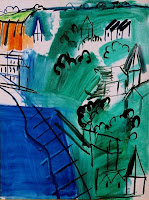 In Paris last weekend I wondered round both the Pompidou and the City of Paris Modern Art Museum which had a fine Dufy exhibition. Later I squeezed into the Frieze Art Fair: a commercial exhibition by a number of galleries. Two things struck me:
In Paris last weekend I wondered round both the Pompidou and the City of Paris Modern Art Museum which had a fine Dufy exhibition. Later I squeezed into the Frieze Art Fair: a commercial exhibition by a number of galleries. Two things struck me:The proportion of works that appealed to me at Frieze was tiny: perhaps one in twenty. By contrast, in a typical municipal contemporary gallery I might like half of what is displayed and covet one quarter. Now one thought is that the latter has much greater quality control. To be on display a work’s artist must meet some sort of accepted standard. He or she must have a reputation in the art world generally or some such. And this serves as a kind of justification for inclusion even if particular works are under par.
But my worry is that even in expectation-challenging conceptual art, there is a kind of cosy familiarity. On a trip down the east of the United States a few years ago I lost count of the Donald Judd ‘draws’. What had seemed only so interesting seen once became more and more appealing seen – over time – en masse. Contra Hume’s remark that:
What we learn not from one object, we can never learn from a hundred. [Hume Treatise 1.3.6]
... another Judd is quite different from one’s first Judd.
The other thing that struck me is how similar in tone are the blurbs written by municipal curators by such works (commercial galleries don’t seem to bother with conveying the truth in art.). Take the line I noticed in the Pompidou:
For him, painting should be abandoned, expressive of a lost social totality.
It doesn’t say: he thought that he should abandon painting. It is more general and normatively compelling than that. But it is not: he thought that painting should be abandoned. That recognises the manifesto in the content but also seems to invite us, the reader, to disregard it. It is merely something he thought. Rather it combines the manifesto: painting should be abandoned, with the weakening device ‘for him’ to produce the characteristic partial endorsement by the curator. The artist must have seen some truth. He or she is an artist after all. But it is a truth that hasn’t been shared by all such artists, many of whom have carried on painting.
